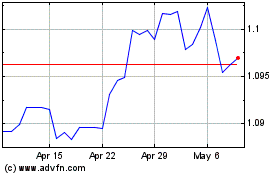Kiwi Rises On Higher RBNZ Inflation Expectations
19 May 2015 - 3:56PM
RTTF2
The New Zealand dollar strengthened against the other major
currencies in the Asian session on Tuesday, after the Reserve Bank
of New Zealand showed that its 2 year inflation expectations have
inched up slightly in the second quarter of 2015.
Data from the Reserve Bank of New Zealand showed that
twelve-months ahead inflation expectations in New Zealand inched up
slightly in the second quarter. Expectations for the next one-year
rose to 1.32 percent from 1.11 percent in the first quarter, the
report revealed. The survey was conducted by the Nielsen
Company.
Inflation expectations in the next 24 months also climbed to
1.85 percent from 1.80 percent in the previous three months
survey.
The currency fell slightly earlier after the release of the
nation's producer price output report.
Data from Statistics New Zealand showed that producer price
output in New Zealand fell 0.9 percent on quarter in the first
quarter of 2015, missing forecasts for a decline of 0.8 percent
after easing 0.1 percent in the previous three months. Producer
price input dropped 1.1 percent on quarter after losing 0.4 percent
in the three months prior.
On a yearly basis, PPI output shed 2.5 percent after losing 0.8
percent in the fourth quarter, while PPI inputs tumbled 4.0 percent
after falling 1.9 percent in the previous three months.
Monday, the NZ dollar fell against its major rivals, amid
expectations that the Reserve Bank of New Zealand is likely to cut
its official cash rate as part of the government measures to curb
Auckland's rising housing market prices. The NZ dollar fell 1.05
percent against the U.S. dollar, 0.60 percent against the Yen, 0.42
percent against the Euro and 0.37 percent against the Australian
dollar on Monday.
In the Asian trading today, the NZ dollar rose to a 4-day high
of 1.5207 against the euro, from an early low of 1.5366. On the
upside, 1.47 is seen as the next resistance level for the kiwi.
Moving away from early 6-day lows of 0.7358 against the U.S.
dollar and 88.28 against the yen, the kiwi advanced to 0.7426 and
89.08, respectively. If the kiwi extends its uptrend, it is likely
to find resistance around 0.77 against the greenback and 90.00
against the yen.
Against the Australian dollar, the kiwi climbed to a 4-day high
of 1.0754 from an early 6-day low of 1.0849. The kiwi may test
support near the 1.05 region. Data from the Conference Board showed
that Australia's leading economic index was down 0.1 percent in
March, following the 0.5 percent increase in February.
The coincident index added 0.5 percent after rising 0.4 percent
in the previous month.
Looking ahead, U.K. consumer, producer and retail price indices
for April, German ZEW economic sentiment index for May and Eurozone
final CPI for April and trade balance for March are due to be
released in the European session.
At 3:00 am ET, European Central Bank Governing Council member
Christian Noyer is expected to speak at a Euromoney conference on
inflation-linked bonds in Paris.
In the New York session, U.S. building permits and housing
starts for April are set to be published.
Bretton Woods Committee 2015 Annual Meeting will be conducted in
Washington D.C. at 8:30 am ET, in which World Bank Managing
Director Sri Mulyani Indrawati, U.S. Treasury Secretary Jacob Lew
and International Monetary Fund head Christine Lagarde are deliver
speeches.
At 11:30 am ET, Bank of Canada Governor Stephen Poloz will
address the Greater Charlottetown Area Chamber of Commerce in
Prince Edward Island, followed by a news conference.
Half-an-hour later, Swiss National Bank director Jean-Pierre
Danthine will deliver a speech titled "Swiss Monetary Policy Facts
and Fictions", in Geneva.
AUD vs NZD (FX:AUDNZD)
Forex Chart
From Mar 2024 to Apr 2024

AUD vs NZD (FX:AUDNZD)
Forex Chart
From Apr 2023 to Apr 2024
